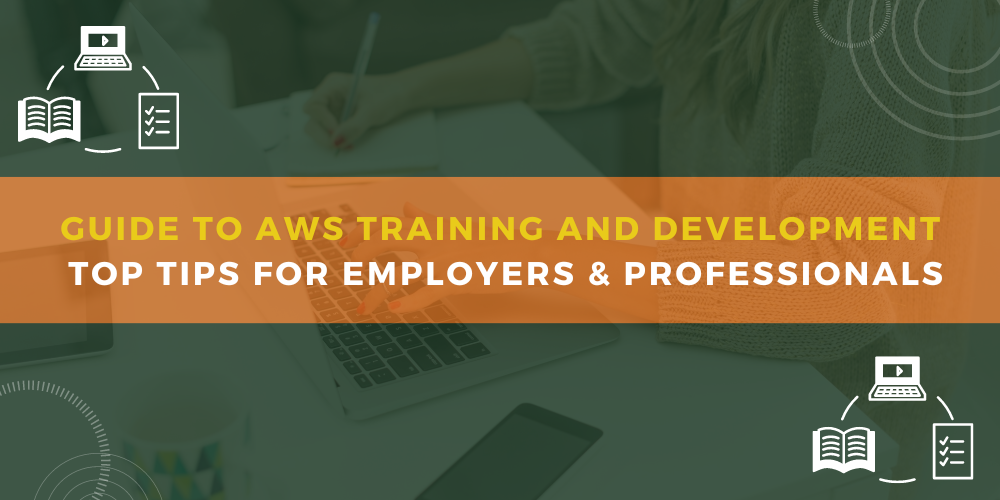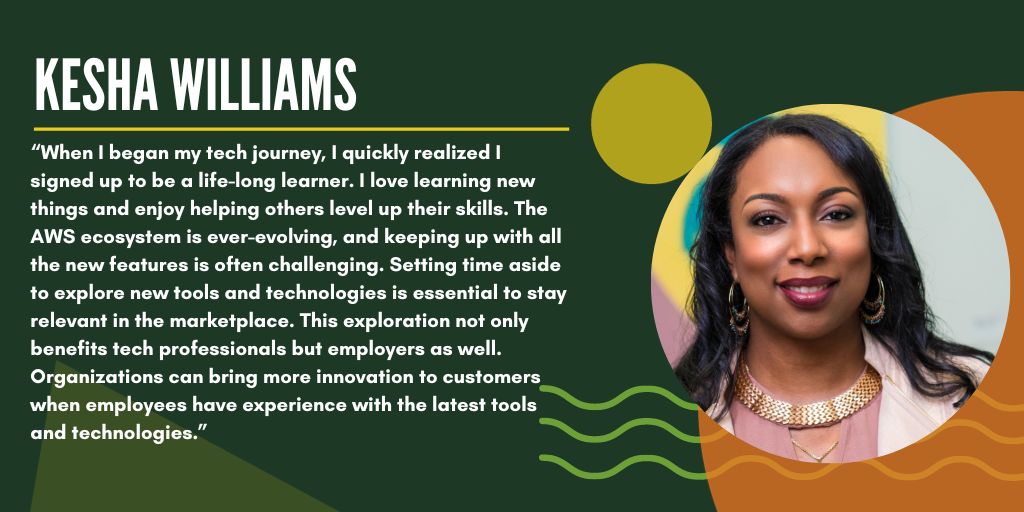
Every year, we survey professionals and organizations working with AWS around the world to find out more about the career and hiring trends shaping this landscape. The result is the Jefferson Frank Careers and Hiring Guide: AWS Edition, which paints a comprehensive picture of the AWS community and offers invaluable insight into the motivations, challenges, developments, and sentiments of those working with this tech day in, day out.
And year after year, we see training and development emerge as an influential factor important to professionals and organizations across the ecosystem. Candidates continuously report their desire to keep learning and upskilling to accelerate their professional development, while more and more organizations report utilizing Learning and Development (L&D) incentives as a way of bridging internal skills gaps, attracting talent, and reducing attrition.
With employee skills training being reported as the most popular strategy used by employers to stay competitive in attracting talent (50%), and building skills in-house emerging as the most popular way organizations are addressing internal skills gaps (52%), it’s clear that training and development remains a top priority.
But what is it about training and development that makes it so popular in the AWS community? What are employers doing right for almost three-fifths of professionals (57%) to report being satisfied with the training and development they receive? How can candidates take charge of their own training, and what can organizations do to accelerate the training of their team?
It’s all rooted in the fast-paced evolution of the cloud. AWS is an ever-evolving technology, and the best professionals want to ensure they remain at the forefront of its applications and innovation. This makes keeping your finger on the pulse through constant learning, relearning, and upskilling essential for professional growth. And of course, this is great news for any employer, providing that you offer the right support. Investing heavily in your team’s training and development ensures that you’re empowering your talent to keep honing their craft successfully, increasing your internal capabilities, and improving your ability to attract and retain top talent.
Recently we caught up with Kesha Williams—a multi-certified AWS Machine Learning Hero, Alexa Champion, and Director in Cloud Engineering who leads teams with a focus on growing early career technologists into cloud professionals and engineering leaders. We spoke with Kesha to dig deeper into why exactly she champions training and development as such an essential part of the community.
Kesha told us:

AWS training and development tips for professionals
So, as an AWS professional, how can you subscribe to becoming a life-long learner and take charge of your own training and development? After all, you can’t always rely on an employer to put the wheels in motion—perhaps you’re a contractor, in-between work, or are one of the 18% of respondents in our Careers and Hiring Guide who report being dissatisfied with the training and development being offered to them.
Below are our top tips for how to optimize your learning by taking the most efficient and effective approach to upskilling and expanding your know-how.
Work towards a certification
Studying for a certification is undoubtedly one of the most popular approaches to training and development—in fact, when we polled AWS professionals on LinkedIn to discover which methods were their favorite way to learn new AWS skills, certifications (42%) came out on top.
And this is hardly surprising when considering the structure AWS certifications provide. One of the toughest challenges when taking charge of your own training and development is knowing where to start and where to go next—with AWS encompassing such a wide range of tech, this can quickly become overwhelming. When working towards a certification, on the other hand, your learning can be much more focused, with the exam scope serving as the perfect framework to guide you through the topics and skills you need to know.
It’s no exaggeration to say that there’s a wealth of resources online to help you study for each certification, too. From the official exam prep and practice questions from AWS, to the comprehensive certification guides on the Jefferson Frank blog, all the information you need is right at your fingertips.
Better yet, you come away with something tangible to show for your efforts, too. 58% of respondents in our Careers and Hiring Guide report holding at least one certification (59% of permanent professionals and 58% of contractors), and over four-fifths (82%) of those believe that these certifications make you a more valuable professional.
This increased market value is representative of the raft of benefits certifications bring. By expanding your knowledge and validating this expertise, many professionals find this approach to training immediately accelerates their professional development, whether that be through a salary increase (60%) or better career progression opportunities (45%), to name just a few.
Attend user groups and events
But certification is only one piece of the puzzle, as Kesha Williams was keen to warn new talent. “Your cloud computing career is a journey that doesn’t happen overnight. Give yourself time to properly learn the fundamentals, and don’t study just to pass a certification exam.”
That’s because, as Kesha goes on to explain, “It’s important to understand how what you’re learning applies to real-world business problems.”
Find an AWS user group in your city to hear from others on how the concepts you’re learning apply to the real world,” she recommends.
Events like conferences and meetups like AWS user groups can be a great way to build your real-life understanding of how to put your knowledge into action. They offer an unrivaled opportunity to expand your network by meeting fellow AWS professionals and learning from thought leaders and major players in the AWS space.
And the importance of this shouldn’t be understated; learning from success stories and case studies, and discussing ideas and opinions with peers, are super-effective ways to level up your understanding of how certain concepts can be successfully leveraged in a particular industry, or to overcome a specific problem.
In hands-on roles like those working with AWS, book learning can only get you so far, so take the steps to get out there, meet your peers, and hear firsthand from the experts in your field. You can find your local user group here, or check out our AWS calendar to avoid missing the next major conference or summit.
Some user groups even host virtual meetups for those who can’t make it in person, and many of the major dates on the AWS calendar include the option to attend virtually. In fact, we found that while 42% of respondents in our Careers and Hiring Guide plan to attend an in-person event this year, a significant 71% plan to join an event online. Just make sure you’re making the extra effort required to connect with other attendees. Jump on event hashtags across X (formerly Twitter) and LinkedIn, and don’t be afraid to ask questions and connect with others in event chatrooms—any opportunity to expand your network offers the chance to learn from new ideas, opinions, and perspectives.
Prioritize online learning
Unless you’ve been living under a rock—actually, even if you’ve been living under a rock—you’re no doubt aware that there’s a whole lot of information available online. Like, a whole lot.
And when it comes to learning about AWS, it’s no different. There’s an entire library of educational content around all things AWS at your disposal, so make sure you take advantage of all the online learning opportunities available to you.
For example, when we polled AWS professionals on LinkedIn, 42% of respondents told us that video tutorials were their favorite way to learn new AWS skills, and this is hardly surprising given how many amazing walkthroughs, demos, deep dives, and speeches are available to watch online. Research suggests that as many as 65% of the population are visual learners, meaning video content is one of the most effective ways of learning for many professionals—especially when studying complex topics that need to be broken down effectively and taken at your own pace.
Top video content recommended by our respondents include:
Elsewhere in our LinkedIn poll, 14% of respondents told us that blogs were their preferred way of learning, with a collection of cloud, tech, and AWS-focused blogs regularly publishing new content around the latest AWS news, tips, insights, and developments. One of our top tips is to turn on Google alerts for AWS articles, meaning you’ll get relevant posts sent directly to your inbox for you to read at your desk, on your commute, or in your own time.
Top blogs recommended by our respondents include:
AWS Partner Network (APN) Blog
However, it’s important to once again highlight the need to get hands-on with this learning—practical application is undoubtedly the most effective way to put your AWS knowledge into action and transform you from a book-smart professional to a real-life problem solver.

Unquestionably, the AWS console is the best place to get experimenting, as Kesha recommends; “Remember that hands-on learning is the best way to retain your newfound knowledge. After learning something new, practice it in the AWS console! Work hard to stay updated with the ever-evolving AWS ecosystem during your journey.”
AWS Console enables you to discover and experiment with over 150 AWS services, many of which you can try for free. This allows you to get hands on without risk, applying the knowledge you’ve gained in a practical environment, and enhancing your learning further still through trial and error, practice, and by exploring new tools and methods.
AWS training and development tips for employers
But what about business, team, and L&D leaders—how can they properly invest in the training and development of their AWS team to bridge internal skills gaps, increase internal capabilities, and successfully attract and retain top talent?
Fund your employee certifications
Certifications don’t just prove beneficial to professionals—far from it! Organizations with teams working towards certifications can take advantage of the expanded knowledge and skill sets their employees gain while studying. This means you can innovate more effective solutions sooner, accelerating project completions and internal efficiencies, all to the benefit of your bottom line.
AWS professionals seem to agree, too. In our Careers and Hiring Guide, 42% of certified respondents told us the biggest benefit of earning certification was increased efficiency at their job, while over a quarter (28%) reported that they brought added skills and value to their organization.
Of course, having a tangible way of demonstrating how you invest in employee L&D proves you walk the walk and not just talk the talk, boosting staff job satisfaction and enhancing your appeal to candidates on the job market.
More and more organizations are waking up to this, too. In fact, almost half (47%) of certified candidates reported that their employer funded their certification in full (43% of end-users, 53% of partners), while a further 18% received partial funding (15% of end-users, 23% of partners).
Our findings show that employer funding remains the most effective way to support employees towards attaining a certification, with 47% of uncertified candidates telling us that this would motivate them to get certified. Costs range between $100-$300 per certificate, depending on the level of the certification.
But that’s not to say organizations who lack the funds to provide financial support can’t still invest in their teams’ certifications. 38% of our respondents told us that paid time off to attend training or study would motivate them to become certified, so consider allocating specific L&D time across the working week, or offering additional annual leave to spend on training and development.
The value of this shouldn’t be understated—of the 38% of professionals who have begun studying for a certification but stopped before taking the exam, the most popular reason given was a lack of time to study because of a high workload (59%). Supporting employees in overcoming these common barriers to certification by keeping their workload manageable and providing additional time and resources is therefore sure to see both you and your team reap the rewards in the long run.
Invest in skills training
Digital courses, skills enablement programs, classroom training, online learning resources—these are just a few of the many approaches you can take to upskill your teams effectively. But whatever the approach, it’s clear that investment in skills training is non-negotiable for many candidates in today’s hiring market.
Many organizations have already caught on to this trend too, with employee skills training (50%) replacing company profit sharing in this year’s Careers and Hiring Guide as the top strategy being used to stay competitive in attracting talent, and a further 22% turning to investment in training programs as a talent attraction strategy.
Of course, this is another instance of investing today to profit tomorrow—the sooner you invest in skills training, the sooner you’ll be reaping the rewards of an upskilled team. Just as long as you invest in the right areas, of course. Perhaps surprisingly, 10% of respondents we surveyed told us that the biggest staffing challenge they anticipate for next year is that their current training program is not effective in upskilling inexperienced candidates.
Unfocused, ill-informed, or ingenuine investment in skills training won’t drive the rewards your employees or your organization wants to see, leading to a whole host of missed opportunities to drive new innovations and attract new talent. So, take the time to understand that training and development isn’t a one-size-fits-all approach—for it to be effective, employers must properly map out what upskilling and progression look like for each member of their team.
For example, despite 18% in our Career and Hiring Guide knowing that they’re dissatisfied with the skills training they’re receiving, 35% of respondents could not directly name what L&D they were missing, demonstrating the importance of giving each employee the guidance they need.
This being said, the common knowledge gaps mentioned by the majority of respondents that you could look to develop in your teams include the following:
- AWS-specific technical training – including certifications
- Artificial Intelligence (AI) and machine learning
- DevOps and Big Data tools – including Python, Kubernetes, and Terraform
- Data science and statistics
- Leadership or management training
- Cloud security
- Project management training or certification
Create mentorship programs
There’s a whole host of benefits to creating meaningful mentorship programs in your organization, helping to bridge internal skills gaps, keeping employees engaged in their development, and attracting a wider range of talent.
That’s probably why, industry-wide, there has been a 30% increase in mentoring initiatives at organizations since the pandemic, and why mentorship ranked as the leading focus for L&D programs in LinkedIn’s 2023 Workplace Learning Report.
But these mentorship programs often prove particularly effective in aiding the training and development of professionals in the tech industry, as Kesha Williams explained to us:

By ensuring experts and senior members of your AWS team are accessible, and perhaps instilling a framework for official mentorship schemes, you can leverage internals skills and knowledge to accelerate the learning and development across your team, regardless of what stage your employees are at in their tech career. Never underestimate the power of being able to pick someone’s brain and be talked through something one-on-one—these moments can be paramount in staying engaged and motivated to learn. You’ve likely got a wide range of expertise and experience on your team, so make sure you use it!
In tech, mentorship also proves particularly effective in creating opportunities to diversify talent pipelines and enable the development of underrepresented groups of talent. For example, in a survey by WeAreTechWomen, 58% of respondents stated that role models are among the top factors that attract them to companies, while 55% of those who had access to mentoring believed it had a positive impact on their careers.
All things considered, it’s no surprise that a third (33%) of organizations in our Careers and Hiring Guide are already implementing new initiatives like mentorship programs as a top EDI priority. Ultimately, the more accessible your mentorship opportunities are to employees and candidates of all backgrounds, experience, and skill levels, the more your organization—and the AWS community as a whole—will keep moving forward.


